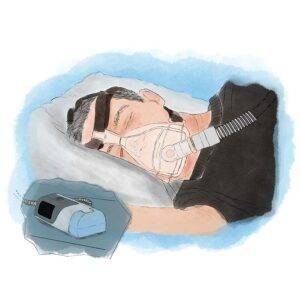 CPAP (continuous positive airway pressure) is a means of assisting breathing. A machine/pump delivers air to a mask (or endotracheal tube). The continuous forward/into-the-airway pressure can keep upper airway breathing passages but also lower airway alveoli (air sacs) from collapsing.
CPAP (continuous positive airway pressure) is a means of assisting breathing. A machine/pump delivers air to a mask (or endotracheal tube). The continuous forward/into-the-airway pressure can keep upper airway breathing passages but also lower airway alveoli (air sacs) from collapsing.
Uses of CPAP
It can help a person who can initiate breathing but lacks the strength to inhale deeply/fully. The patient’s weak inward “suction” is supplemented by the externally-provided inward pressure.
In a person with loud snoring or sleep apnea, the positive pressure can also prevent collapse of a flaccid airway.
In a third scenario, a person might have a narrowed upper airway passage due to acute swelling or chronic scarring/stenosis. Even with strong breathing effort, this person might tire from the work of breathing. CPAP can markedly reduce that work.
Another important use is to prevent, or press out, edema from a recently-operated laryngopharynx. Just as compression stockings or a sequential compression device can prevent or press out edema from the lower legs, CPAP appears to have a similar effect in the airway. As such, it can be used after surgery such as posterior commissuroplasty during the initial postoperative period when swelling is most likely.